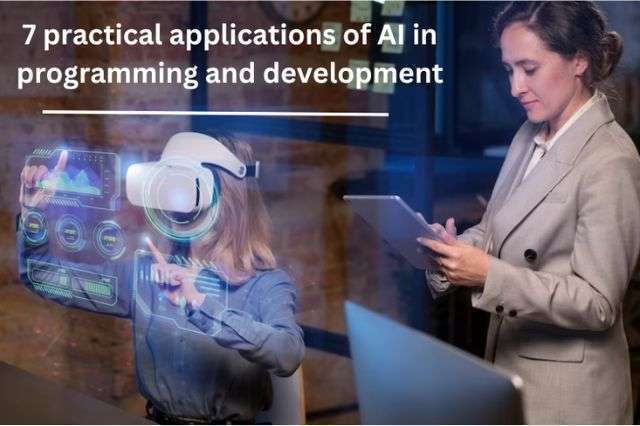7 Use Cases of AI in Programming and Development (& 4 Where AI Fails)
Four researchers at Oak Ridge National Laboratory published a paper half a decade ago pondering whether humans will still be writing code in 2040. This question now finds a home in the heads of most ordinary programmers. There are apprehensions and expectations about what the answer to the question entails.
The researchers answered the questions in the negative: machines will generate most of the code while humans, if they do get involved, will be confined mostly to refining machine-generated codes.
The rapid progress made in the field of AI has brought the prediction to realization much sooner. Various AI systems now exist that can generate functional codes from mere descriptions and even sketches. This brings with it promises as well as pitfalls. AI can increase productivity, unleash human potential and creativity by taking over menial and tedious tasks, and thus open up new opportunities. However, it can also perpetuate bias, reduce accountability, and increase the risk of catastrophic errors by removing human oversight.
So, here, we consider seven use cases of AI in programming and software development and also evaluate cases where it falters.
Common use cases of AI in programming
AI has impacted every aspect of work, including—in fact, especially—programming and software development. According to one survey, 31% of organizations use AI for writing code. The question that is now asked is not whether AI will impact software development but how and to what degree.
Programming is one of the areas where AI has contributed greatly to an increase in productivity and efficiency. A report by LinkedIn on the future of work predicts that 96% of software development tasks can be augmented by AI. AI-powered tools have been used across a spectrum of tasks, from the basic to moderately complex.
-
Generate code snippets
AI tools, trained with millions of lines of code from publicly available repositories such as GitHub and StackOverflow, can generate snippets of code in a fraction of the time it takes a human to write the same. They are proficient in multiple languages and can produce code from natural language.
This is helpful not just for beginners but for skilled programmers, who could let AI write the simple code they need. They can then tweak or refine it, and implement it in their program.
AI can be particularly good at generating code templates. You can provide the AI tools, such as GitHub Copilot, with a set of parameters and the AI will generate a code template. This can be useful for creating boilerplate or repetitive lines of code. AI can also help with code completions by suggesting what’s most likely to follow, not unlike text autocomplete. You can also paste your incomplete code into an AI coding assistant and let it complete the code.
-
Debug code
Bugs are a bane of every programmer. They can be a time sink (for example, spending hours figuring out why a code would not run only to realize it’s because of a missing semicolon), but they also pose critical security risks and compromise user experience. AI can mitigate some of these. And not just that: AI can identify bugs more accurately and quickly.
AI can analyze code to detect bugs by identifying inconsistencies and patterns that commonly lead to errors. It can recognize code structures that often result in bugs and alert developers to potential issues. AI can also help with regression testing and ensure that new changes don’t introduce bugs in the codebase.
This does not, however, mean that debugging can be entirely entrusted to AI. What it means is that humans can delegate some of the menial and tedious tasks of debugging to AI, which will allow them to save plenty of time on avoidable work and dedicate more time to tasks that are more productive.
-
Translate code
Say you want to migrate from one platform or environment to another or reuse existing logic and functionality of a code in a new context. In both of these instances, you can use AI to help you translate the code without needing to rewrite the code from scratch.
However, AI tools for translating code are not entirely reliable. They may fail to notice the nuances of a language or be unable to grasp the logic of a code; but so do humans. Even if the translations are not perfectly accurate, it’ll make the task much easier than manually translating the source code from scratch. It is also like working with human translators; the translated code is reviewed and corrected, if there are errors.
-
Explain code in natural language
AI can explain code in plain English (or in any language for that matter). This can be helpful if you are learning a new language or if you encounter random lines of code that you have no idea what it does.
Similarly, AI can decode regular expressions and explain in natural language what they do.
It can not only explain obscure lines of code but can help explain them, too. AI can create comprehensive code documentation that accurately describes the purpose, functionality, and usage of code. AI can also help with reviewing and documenting code submissions and generate explanations of changes made in pull requests or commits.
-
Test case generation
Thorough testing of code is critical to ensure that the program works as intended. But writing test cases and testing the code is a tedious and time-consuming process—and therefore often overlooked. Thankfully, AI can help with this task.
AI can be used to write test cases by analyzing the codebase and identifying potential scenarios for testing. It can identify different paths, branches, and conditions within the code and create test cases to cover those scenarios.
AI assistants such as Tabnine can automatically generate unit tests and execute the tests themselves with minimal human intervention. They then flag and report any failed test cases and provide a summary of the tests. This can help improve testing efficiency and reduce the burden on humans.
[Source-https://www.tabnine.com/blog/wp-content/uploads/2023/02/unittestgen.gif]
-
Code refactoring
Refactoring code is another time-consuming and humdrum task that AI can help with. AI can help reduce the time spent debugging and refactoring by about half.
AI can automate refactoring tasks such as renaming variables or methods, extracting code into functions, reorganizing code structure, or reducing complexity and enhancing the extensibility of code.
Using AI for code refactoring not only reduces time and effort but also helps identify code smells and helps fix potential problems early in the development process. This reduces the risk of bugs and technical debt.
-
Generate synthetic data
Synthetic data comes in handy when real data is unavailable or cannot be used because it contains sensitive information. Synthetic data eliminates the constraints associated with the use of regulated or confidential data as it contains no personal information.
AI can be used to generate all sorts of synthetic data that closely resemble real-world examples. AI can also create synthetic data for rare or extreme scenarios that are difficult to reproduce with real data. This can be used to test the resilience of the software under unusual conditions.
AI can also help generate synthetic data that can be used to augment real datasets, balancing class distribution and introducing variations.
However, AI is not a magic potion
AI has made remarkable progress in its coding capability, especially in the last couple of years. AI assistants have become adept at automating routine and menial tasks, but they stumble at tasks that require critical thinking. They cannot understand the underlying principles and concepts of software; they have trouble keeping up with new frameworks and paradigms; and they are unable to completely grasp real-life scenarios.
Here are four cases where AI assistants are not reliable and why, therefore, you need to hire app developers for your project.
-
Architecting complex software systems
AI systems lack the level of understanding required to design and implement complex processes. Although they can create sufficiently complex functions in isolation, they falter when they have to integrate them and keep account of dependencies from other code.
-
Understanding intuitive user needs
Understanding and conceptualizing user needs and preferences require empathy, context, and awareness of human behavior and emotion—qualities that AI tools lack. This limitation of AI systems in understanding emotional context, subjectivity, and the nuanced aspects of intuitive user needs makes them less competent compared to human experts.
-
Handling legacy codebases
AI tools struggle to fully address legacy codebases, which are old and often outdated. Such codebases generally lack sufficient test coverage and documentation, which hinders the effectiveness of AI tools.
-
Working with new frameworks and paradigms
Data is the bread and butter of AI models. For relatively new frameworks and paradigms, sufficient data is not available to train the AI systems. This makes them unreliable and even risky; for they, instead of admitting ignorance, will give incorrect answers with a high degree of confidence. This hallucination tendency can easily mislead even the most circumspect.
Related post: Why Use AI and ML for Enhancing Your Date Entry Process
Final takeaway
AI has made huge strides in the field of programming and software development in the last few years. AI systems have made programming more efficient and streamlined. They have impacted various other dimensions of software development as well. But they remain just that: tools! AI needs a human to instruct and oversee its operations and judge the quality of its outcome.
Even with tasks they excel in, they require human supervision. And for others, they simply fall flat. Human input and expertise remain indispensable in software development, and this is why web app development companies continue to play a significant role.








